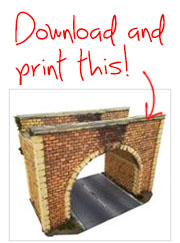“I found the best method to make a realistic waterfall.
Lay out a sheet of cling film. Measure on it the height of the desired drop. Using clear sealant, starting from the “top” drag the sealant in close lines down to the “bottom”. as the sealant dries, use a fork to lift peaks away from the flow and create suitable turbulance at the “base.
leave to dry. paint the peaks and the turbulence with touches of white gloss paint.
remove the waterfall by pulling the cling film away (it doesn’t matter too much if some is still attached).
the waterfall can then be fixed in place by using a little more sealant at the top and bottom.
the rock face behind the waterfall should first be suitably painted and this will show through any gaps
it looks very realistic.
regards
Dick”
I’ve asked Dick for some pics.But when it comes to waterfalls:
But Arnie’s is the main event in this missive.
And don’t forget there’s lots of stuff on ebay that sets just like water.
Keep ’em coming.
Oh – one last thing. If you’ve got more than one hobby, and it seems most of you have, you may find this interesting myotherhobby.com. Thought it would be a bit of fun.
Best
Al





Hi Dick,
Great tip for the waterfall, and I think that if you smear a very thin amount of cooking oil over the cling film it would come away cleanly.
I’m thoroughly confused. From ‘cling film,’ through ‘following lines with sealant,’ to ‘removing it.’
Example: SEALANT, to me, closes off something. I thought that I understood his application until he removed his hand-work, but wrote that anything that still clung to the WATERFALL(?) was okay.
Was he painting water on (clear, thin, bowl covering) saran wrap-like material that he fastened to the actual drop? If so, then why remove it?
Please, someone, anyone unsramble the man’s sentences for me.
Mike
Arnie – Great job I really need to get back into creating my layout after seeing your pictures.
I would love to see some photos too.
Paul otway
Hey Mike, I’m sure he is talking about clear sealant in a tube that seals doors, windows, bathtubs, etc. Make lines of that on a piece of clear “Saran Wrap”. If some of the Saran Wrap stays with the sealant it won’t show so no problem. I imagine that if all of the clear wrap was left, it wouldn’t look right. I hope I’m right.
Yes please people make your post more exact, not everyone can understand what you are doing and what material is. Thanks so much, good tips.
tom
I am definitely confused on the water fall making. Not understanding the clear sealant, the saran wrap, etc…Pictures would help me to better understand how to make these water falls which I am very interested in.
It seems pretty straightforward to me. I suggest that you people that can’t follow the description stay well away from self assembly furniture.
Ashley Herbert…
I purchased a box of “Self-Assembly Furniture” and discovered it does not assemble itself!
All joking aside, I understood Dick’s waterfall instructions very well… And also why he used generic terms for the products he uses..
In the United States, “Cling Film” is the common “Saran Wrap” though there are other manufacturers and who knows what it might be in other countries.
As for myself, I wonder how well waxed paper might work…
Likewise, “Clear Sealant” is one of the many brands of clear silicone caulking. The stuff is gooey, sticky, and annoying to work with. It is commonly used to seal leaks around bathtubs, faucets, and any other area where a water leak is a problem. It can be used as an adhesive as well. It is not as clear as the name implies but it is not opaque either. In the United States one can purchase it in both very small tubes for very small projects (like a waterfall) or in larger tubes for larger projects.
Hope this helps… Like everything, experimentation and a few failures are where you start… With experience, your work gets better/ It is all about making a start as Al says.
Be nice everybody. We all learn in different ways. Some can learn from instructions only and some need to see pictures to learn. Some learn by doing and others learn by example. This is a great hobby and we have all made our mistakes. Belittling someone who can’t “see” what we see on serves to drive people away and discourages questions which are so vital to the learning process.
I find waxed baking paper works better as sealant won’t stick to it at all
I am with Lynn; I love to read and look at the photos, although I have never attempted to make a layout myself. Like some other hobbies I have been involved in, it only takes a few negative comments to ruin things for some people. Please keep your comments constructive.
Constructive comments are best. What I think he did was to create the falling water portion of the waterfall on his bench. He measured the space for the ‘structure’, height and width. I would draw that shape on a flat sheet of craft paper. The he laid out the cling wrap on the bench and applied the clear sealant as described. He made the sealant slips exactly the correct height but a bit wider. Then, using a fork (or similar tool), he scrunched up the sides to the exact width he needed. He then finished the piece as described for the final water effect. When the structure is dry, it was peeled off the cling wrap and attached to the face of the cliff to create the falling water.
At least, that is how I read it.